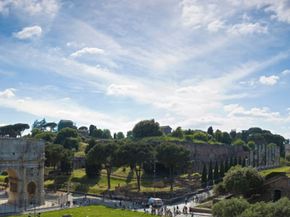Ciao, Roma!
Exquisite marble. Soaring umbrella pine trees. Priceless paintings and sculptures by Bernini, Michelangelo, Raphael. Ghostly ruins rising from the Palatine and Capitoline hills. Gypsies. Pickpockets. Street vendors. Renaissance cathedrals. Gelato in every flavor you can imagine -- and then some. Tourists crowding the Spanish Steps and jostling before the Trevi Fountain. Businessmen on Vespa scooters. Hordes of pedestrians thronging the streets, ignoring the honking of tour buses and exasperated locals.
Advertisement
No one who has visited Rome can doubt the aptness of its nickname, the Eternal City. And no one who has spent an afternoon sipping wine and people-watching in a sidewalk trattoria will ever forget it. Few destinations are as culturally rich or awe-inspiring.
Rome is the heart of the Italian region of Latium. For centuries, the area has been a crossroads of cultures -- a center of trade, political power, religion, art and agriculture. It's also a crossroads of geological faults [source: BBC]. Beneath all that lively culture is potentially violent volcanic activity of the sort that destroyed ancient Pompeii. But for that very reason, Latium produces wonderful, distinctive grapes and wines.
Rome, as the saying goes, was not built in a day. Nearly 3,000 years of civilization have gone into the viniculture of the Eternal City, which is recognized as one of the world's foremost wine producers. This article examines some of Latium's finest wines. But first, we need a strong foundation. We'll look at the history of Latium and the various influences -- both sociopolitical and geological -- that have shaped its wine production.
Advertisement
